|
In 1905, at nineteen years of
age, Eunie (now calling herself Eula) married a man named R.H. Burgess. The 1910 census reported that
24-year-old Eula Burgess, an "actress," was living with her parents;
her marital status is listed as "divorced." No information
about her former husband, Mr. Burgess, is given. Time magazine reported that
Ouida was born "Ida Berger."3 It is uncertain whether
Ouida in fact used that name at some point, or whether Time got
it wrong. One can't help but wonder how much of the "official" biography
is actually true. Early Career Apparently, Ouida did indeed have a brief career as an actress. The Internet Movie Database (IMDb) lists two movie credits to Ouida Bergere. In addition to repeating the "official" story of where Ouida was born etc., IMDb lists a man named Louis Weadock as one of Ouida's husbands. Ouida's bio is here: http://www.imdb.com/name/nm0075160/bio So why did Eunie Branch choose the name "Ouida" (pronounced wee-duh) as her professional name? Ouida was the pseudonym of Marie Louise de la Ramée, a British novelist (1839-1908). Eunie may have been a fan of this writer. But the name "Ouida" was also a popular name in the early twentieth century.4 She may simply have liked the name. It sounds French, so it goes well with her exotic fictional background. Did Basil know that Ouida was born in Arkansas? In True Story magazine, Basil wrote "The girl I married was born in the United States—in Virginia."5 It's interesting that he didn't give the official story (born on a train to Madrid)! There is no evidence that he knew she was born with a different name, though it's reasonable to assume that a wife would tell her husband about her background.
In addition to her writing career, Ouida worked as an agent for other actresses and actors to directors and producers. With one office in New York City, she expanded her service in 1917 and opened branch offices in London and Los Angeles. (See image of newspaper clipping to the right.) It's unknown how successful this agency was. By the time Ouida married Basil (1926) the agency no longer existed.
How Basil Met Ouida Basil and Ouida met in November 1923. It wasn't the first time that she had seen him, however. Ouida had seen Basil's performance in The Czarina in 1921, and promptly announced to her companion that she intended to marry that man! Nevermind that she was married to George Fitzmaurice! Two years later Basil's friend Clifton Webb invited him to a party at Ouida's house. In his autobiography, Basil wrote that he brought a girlfriend to the party, June.7 In True Story magazine, he didn't mention June, but wrote, "Having nothing better to do, I went with Clifton to the party."8 In an article about Rathbone, written in 1940, journalist Kirtley Baskette wrote that Basil and Ouida met at a Manhattan party. "Before the party was over they were in love. A few weeks later they were married."9 That's not how Basil told the story. He was introduced to Ouida at the party, but they didn't have an opportunity to talk. "To say that I fell in love with her that day would be stretching the truth. As a matter of fact, we said scarcely a dozen words to each other. But afterward I found myself remembering the sound of her voice and the way her lips curved when she smiled. I began to wonder if she had seen our play."10 Some time later, he went horseback riding, and Ouida was part of the group. "Ouida, I discovered, was an expert horsewoman, and she liked to ride fast. Soon the two of us had galloped far ahead of the rest of the crowd. . . . We talked of London, the English countryside, of places we both loved. . . . Gradually our talk took on that heady something that creeps into conversation when two people first begin to realize that they like each other and have mutual tastes and interests. . . . That was the beginning. After that we saw each other frequently. Sometimes we had dinner together. Sometimes we met after the theater, had supper somewhere and talked far into the night. We went to symphony concerts together, to art galleries. But no matter where we went, what we did, there never seemed to be quite enough time to say to each other all the things we had to say."11 In time they decided that they were meant for each other. Basil proposed to Ouida at the corner of Fifth Avenue and Fifty-fourth Street, while waiting for the traffic light to change. The article in True Story indicates that they fell in love gradually, over the course of many dinners and concerts. But in an interview for Movie Mirror Basil said that he knew he was in love at the end of that first day of horseback riding.12 His autobiography suggests the same thing. "I turned her to me, took her in my arms and kissed her. ... To myself I said, 'This is not the same ... it mustn't be ... There comes a time when it must be forever.'"13 Regardless of how quickly they fell in love, eventually they did decide to marry. But first they each needed to obtain a divorce.
Basil wrote, "I knew that she was separated from her husband, but I did not know how she felt about divorce."14 It's a very strange comment, considering that Ouida had been divorced twice before (from Mr. Burgess and Mr. Weadock). Is it possible that Basil didn't know about Ouida's previous marriages?
On June 18, 1925, The
New York Review reported, “Basil Rathbone, leading man for Elsie Ferguson at the Biltmore Theatre, has admitted
his engagement to Ouida Bergere, former wife of George Fitzmaurice, the picture
director. . . . Fitzmaurice was
awarded a divorce from his wife here in December on the grounds of
desertion.” Basil also obtained a divorce from Marion Foreman, then he and
Ouida proceeded with their wedding plans. The Wedding Basil and Ouida were married on April 18, 1926, in New York City. In his autobiography, Basil explains that because both he and Ouida were divorced, the priests of their respective faiths (Episcopal and Catholic) would not perform the wedding ceremony.15 It may have been equally difficult to find a church that would allow them to marry—or perhaps it was their choice not to have the ceremony in a church. In any case, Basil and Ouida tied the knot at the home of a friend, Joseph Thomas, with Father Hampden of the Dutch Reformed Church presiding. Movie Mirror reported:
The newlyweds moved into an apartment in the Beekman mansion, No. 439 East Fifty-first street. In "Why I Am a Happy Man," an article for True Story magazine, Basil wrote about Ouida, "Before we were married she was outstandingly successful as a scenario writer. She gave up writing, because she believes that a woman's job is to create a home for her husband, and to put his interests ahead of her own."17 It's interesting that when Ouida married George Fitzmaurice, she did not give up writing. Apparently, at that time she did not believe a woman's job was to create a home for her husband. At least not for that husband. Basil gives the impression that Ouida had plenty of money ("outstandingly successful") and a lucrative career that she gave up. In an interview for Photoplay, Basil noted that Paramount was paying Ouida thousands of dollars a week.18 And yet, just eight weeks after the wedding, Ouida filed for bankruptcy. She listed personal assets of $150 and liabilities of $9,399. The notice printed in the New York Times details the specific liabilities.
But Basil never mentions the bankruptcy nor Ouida's extravagant spending habits. Rather, he credits her with being practical. "When Ouida does anything she does it right."19 "If I've changed, " said Basil ... "and learned how to enjoy people and places and everything that goes on about us today, it's because of Ouida. She is so vital, so sophisticated in every sense of the word, that I couldn't lag behind. ... Her appreciation of fine music, of the theatre, of art was one of our first bonds. But it is her relish for exacting the most from every waking moment that enchants me, I suppose."20 "When I come home in the evening it is to a home that has been created about me and which I feel at once happy. My wife has a quality of relaxation and assurance about her which immediately restores me. She is small but colourful, dainty but strong. She always reminds me of a Goya painting. I draw new life from her."21 In Movie Mirror Benn Maddox wrote: "Ouida is one of those amazing women who are born to accomplish. She has all the feminine graces, intelligence, an undaunted driving force, and tireless vitality. She is cultured traveled, cosmopolitan in every respect. She has no petty vanities or jealousies. Her ideas aren't limited by ignorance. She has a warm heart; she is a good friend."22 Radio and Television Mirror reported: "One of the finest gifts his wife ever brought him, Basil believes, was the reunion with his son, Rodion. Rodion is the son of Basil's first wife, from whom he was separated in 1919. When Basil came to America, Rodion stayed with his mother in England, was raised there and educated as an engineer. The long years that separated them made him a stranger to Basil. Knowing that bringing them together again would mean much to her husband's happiness, Ouida, unknown to Basil, made friends with Rodion in England and made friends with him, too. It was entirely through her efforts that Basil and his son were brought together again in Hollywood."23 This is a lovely story, but at least one person who was close to Basil claims that the story was a lie, fabricated by Ouida. A follower of The Baz commented: "She had done everything she could to keep Basil from communicating with his son and only reluctantly agreed when he said he would go to the UK alone if she didn’t want to go with him. ... Basil went to see his son whom he hadn’t seen in a number of years and she went along and then told everyone she had fixed up a reunion. ... The “truth” to her was what she wanted herself and others to believe."24 If this is true, why did Basil agree to perpetuate the lie? Did he love Ouida so much that he was willing to lie for her? Perhaps he saw no harm in letting her have her fantasies.
The Hollywood Hostess Ouida Rathbone was famous for her extravagant parties. Liberty magazine reported, "Mrs. Rathbone is the most successful party giver in Hollywood. Her hospitality had long been famous in her immediate circle before she achieved high visibility as a big-time deluxe model hostess. ... Her parties became the talk of the town, of the whole theatrical profession. ... Before meeting Ouida [Basil] loathed parties, especially Hollywood parties. Now he is a part of the greatest party-giving team west of the Mississippi, and liking it."25 In an interview, Basil said, “I'm an unsocial person. ... It's my wife who loves to entertain. She does all the work. She is a brilliant, amazingly versatile woman who abandoned her own career of writing when we married. Now, in parties, her executive, artistic and romantic talents get a chance for expression.”26 Ouida herself said that Basil “loathes parties and really suffers when he has to attend them. It isn’t that he dislikes people. But he loves to know them well. He adores conversation. If he meets people who interest him, he likes to talk to them at length, compare their viewpoints about innumerable subjects with him … a pleasure denied him at large parties.”27 But in the same article she wrote the following: “We do not entertain often, but when we do, we aim for the perfect party. He planned with me for weeks for our Christmas party last year. He applauded my ideas for everything from decorations to hors d’oeuvres. The night of the party he didn’t even wait for the doorbell to ring. He stood outside and greeted his guests at the gate!”28 Time magazine described Ouida's parties as "a fulmination of her blood, a bounding along the veins, which eventually detonates in something pyrotechnic, exotic, ingenious and rare."29 The following is a description of a party that Ouida gave in honor of classical pianist Arthur Rubinstein. Fifty-four guests attended:
Hollywood columnist Ed Sullivan wrote the following about another one of Ouida's parties, given in the spring of 1939: "Arc lights, clusters of them, outlined the huge brown circus tent, big enough for a Ringling Circus performance. ... Twin dance floors occupied the main part of the tented interior . . . The acres of tables started filling with formally dressed women and their escorts . . . Before the evening was over the caterers had served over eight hundred dinners."31 Yes, Ouida held some fantastic parties, and these gave her the reputation of being the Hollywood hostess. When the United States entered World War II, Ouida became actively involved in supporting the war effort and raising funds. In 1943 she was the chairperson of the premiere committee of the United Nations War Relief. According to Basil's autobiography and various magazine articles, Ouida's taste in music lent toward Stravinsky, Debussy and Scriabine. In art, she liked the impressionistic and mystical. She didn't indulge in any team sports, but enjoyed riding, swimming and walking. Ouida loved to dance and drive fast. She considered herself an authority on interior decorating, and decorated the rooms in her home. Ouida never learned to sew, but Basil learned how to sew in the army. She and Basil shared a love of dogs and reading.
One would think that such a multi-talented woman as Ouida would be very popular, and have lots of people singing her praises. But research has failed to uncover anyone besides Basil who even admits to liking her. One person who knew Ouida commented on The Baz that:
If Basil complained about Ouida's overspending or her lies, he did so privately. His autobiography and all interviews with Basil indicate that he worshipped her. As far as the public could tell, Basil and Ouida were happily married. And this supposedly happy union lasted until Basil's death in 1967. Basil's estate was around $10,000 or less. When that money was gone, Ouida had to borrow from friends. After daughter Cynthia passed away in 1969, Ouida lived alone. She died in 1974 at age 88.
Ouida's Partially-true Biography The "official" version of Ouida's biography, as printed in California and the Californians, appears here:
Notes 1. Kirtley Baskette, "Love Life of a Villain," Photoplay magazine (August 1938), p. 15 2. source: http://thegreatbaz.wordpress.com/2012/12/07/a-closer-look-at-the-second-mrs-rathbone/ . Also see the Wikipedia article on Ouida Bergere. 3. "Folies Bergère," Time magazine (February 26, 1940) 4. "Think Baby Names," online at http://www.thinkbabynames.com/meaning/0/Ouida 5. Basil Rathbone, "Why I Am a Happy Man," True Story (July, 1940), p. 63 6. "Folies Bergère," Time magazine (February 26, 1940) 7. Basil Rathbone, In and Out of Character: An Autobiography (New York: Doubleday, hardcover, 1962), p. 53-54 8. "Why I Am a Happy Man," p. 63 9. Kirtley Baskette, "Marriage Brought Him Everything," Radio and Television Mirror (April, 1940), p. 16 10. "Why I Am a Happy Man," p. 63 11. "Why I Am a Happy Man," p. 64 12. Benn Maddox, "Six Months to Love," Movie Mirror (January 1938), p. 70 13 In and Out of Character, p. 57 14. "Why I Am a Happy Man," p. 64 15 In and Out of Character, p. 70 16. "Six Months to Love," p. 37 17. "Why I Am a Happy Man," p. 64 18. "Love Life of a Villain," p. 67 19. "Love Life of a Villain," p. 67 20. George Benjamin, "Buoyant Battler: Exposing Hollywood's #1 Sophisticate, Basil Rathbone," Modern Screen (December, 1937), p. 88. 21. "Love Life of a Villain," p. 67 22. "Six Months to Love," p. 70 23. "Marriage Brought Him Everything," p. 90 24. Reader's comments on The Baz: http://thegreatbaz.wordpress.com/2012/07/26/the-best-candids-ever-ii/comment-page-1/#comment-349 http://thegreatbaz.wordpress.com/2012/07/26/the-best-candids-ever-ii/comment-page-1/#comment-314 25. Frederick L Collins, "Hollywood Hostess—Mrs. Basil Rathbone," Liberty (September 14, 1940), p. 15 26. Dickson Morley, "First Host of Hollywood," Picture Play (February, 1938) 27. Ouida Rathbone (as told to Grace Mack), "He's not a Villain at Home!" Screen Book Magazine (December 1936), p. 89 28. "He's not a Villain at Home!" p. 88 29. "Folies Bergère," Time magazine (February 26, 1940) 30. "Hollywood Hostess," p. 15 31. "Hollywood Hostess," p. 15 32. Reader's comments on The Baz: http://thegreatbaz.wordpress.com/2012/09/02/biography-week-qa-with-robert-matzen/#comment-808
|







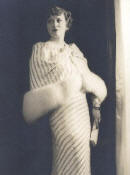
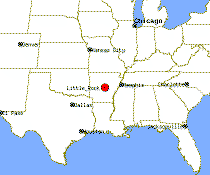

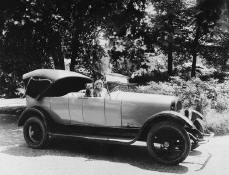
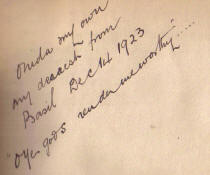
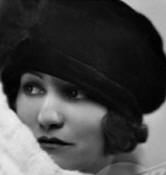
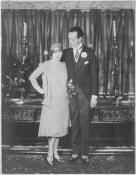


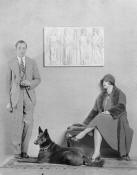

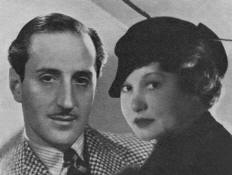
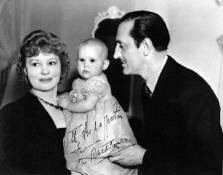
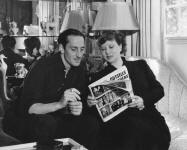
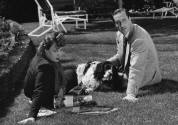
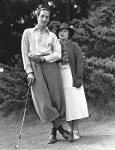
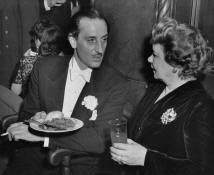

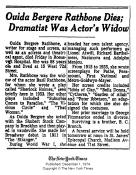
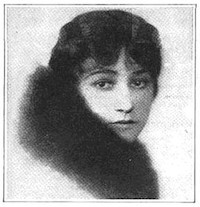 Miss Bergere became associated with the stage when she was but a girl.
Winchell Smith, the well-known playwright, gave her a first opportunity to
play a part, and her talent enabled her to make rapid progress, but an
affliction came to her in the loss of her voice, so that she was compelled
to abandon her stage career. Under these conditions she showed the
versatility of her talent by turning her attention to literary pursuits. She
thus wrote for the New York Herald and for various magazines, besides
writing stories for motion-picture production. The silver-screen industry
eventually enlisted her attention to such an extent that she learned
virtually all things pertaining to the production of motion pictures and
their business exploitation. She wrote and directed plays, designed costumes
and stage settings, wrote titles, did the cutting of films, and appeared in
leading roles. Thus she gained wide experience in the earlier period of
modern motion-picture production, and she has won much success and
distinction in connection with this great industry and art. She wrote most
of the stories for the various films in which Elsie Ferguson was starred,
many of the best for May Murray, including On With the Dance, in which Miss
Murray registered her first great claim to stellar honors. Miss Bergere has
written many stories also for Pola Negri, for Corinne Griffith and for
others who have won stardom. She prepared in 1920 the screen version of
Peter Ibbetson, in which Elsie Ferguson and Wallace Reid appeared. In this
connection fate played for her a most gracious part, for it was in this
connection that she met Basil Rathbone, who was playing lead in the stage
production of this play, this casual meeting having ripened into a
friendship that culminated in marriage, in 1926.
Miss Bergere became associated with the stage when she was but a girl.
Winchell Smith, the well-known playwright, gave her a first opportunity to
play a part, and her talent enabled her to make rapid progress, but an
affliction came to her in the loss of her voice, so that she was compelled
to abandon her stage career. Under these conditions she showed the
versatility of her talent by turning her attention to literary pursuits. She
thus wrote for the New York Herald and for various magazines, besides
writing stories for motion-picture production. The silver-screen industry
eventually enlisted her attention to such an extent that she learned
virtually all things pertaining to the production of motion pictures and
their business exploitation. She wrote and directed plays, designed costumes
and stage settings, wrote titles, did the cutting of films, and appeared in
leading roles. Thus she gained wide experience in the earlier period of
modern motion-picture production, and she has won much success and
distinction in connection with this great industry and art. She wrote most
of the stories for the various films in which Elsie Ferguson was starred,
many of the best for May Murray, including On With the Dance, in which Miss
Murray registered her first great claim to stellar honors. Miss Bergere has
written many stories also for Pola Negri, for Corinne Griffith and for
others who have won stardom. She prepared in 1920 the screen version of
Peter Ibbetson, in which Elsie Ferguson and Wallace Reid appeared. In this
connection fate played for her a most gracious part, for it was in this
connection that she met Basil Rathbone, who was playing lead in the stage
production of this play, this casual meeting having ripened into a
friendship that culminated in marriage, in 1926.